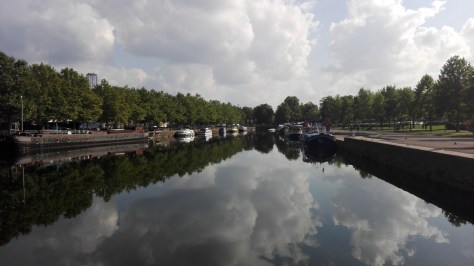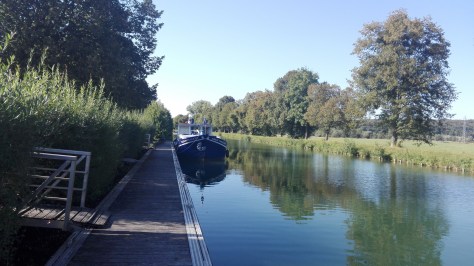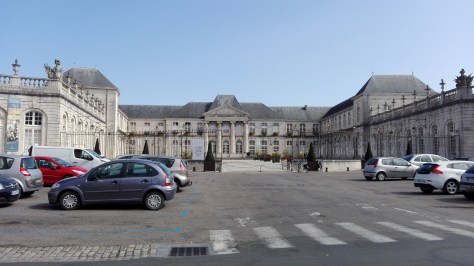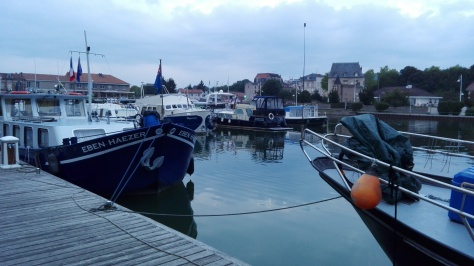Lesson Number One from our first season – Just. Slow. Down. If you think you are travelling slowly enough – Slow. Down. Some. More.
This rule applies both to the speed at which you and your boat are travelling at any given time, and also to the distance you try to cover in any given day, week, month or season.
Speed
Our boat displaces more than 30 tonnes and is around 19 metres long. It is driven by a 110 horsepower motor with a throttle but no gears apart from forward, reverse and neutral. It doesn’t have brakes. It has a flat bottom with no keel, which gives access to shallows but also means it has no cut through the water, performing more like a puck on ice.
These characteristics always formed a part of our consciousness, but it took time for us to realise just how much they meant. You just learn from experience, I guess, that approaching locks, banks, quays and other craft – indeed any manoeuvre or operation – demands a calmness, a slow speed and a willingness to back off and try again rather than resorting to more throttle and radical rudder.
There can be pressure to speed up, when you have another boat waiting behind you as you enter a lock, or waiting on the other side for you to complete your entry and exit so they can take their turn. As the season wore on we learned to ignore that pressure and go at our own pace.
Plus, it’s a barge. It’s not a fancy lightweight plastic boat with double bow and stern bowthrusters that can move it sideways, stop quickly when reverse is engaged or take tight angles. There’s no point in trying to operate the boat as a sportscraft.
Slow. Graceful. Calm. Incident-free. The way to go.
Distance
We definitely planned our initial season badly, trying to cover too much in too short a time. We are glad that circumstances (and friendly advice) more or less forced us to curtail our trip early, stopping in Épinal rather than trying to push on in haste to Roanne.
The thing is, you are travelling at not much more than 5-6 kilometres an hour – on a canal the official limit is 6kph in any case. And there are so many things to see, and so many more that present themselves unexpectedly.
Our first season saw about an equal split between days of travel and days of rest. I think in the future we would increase the ratio of days of rest by at least 50% and better still double them – two days of rest for every day of travel.
This would give you the time to stay in a place for a while, get to know it, relax and enjoy the town/village/countryside without always thinking about the next cruise day, the next stopover.
Especially early on, we had days of travel where we were underway for 7-8 hours. I see blogs and accounts of other cruisers where this seems common. We have decided that apart from special sectors that demand it, this is too much. We want to leave a place relaxed and at a civilised hour, and travel until no later than early-mid afternoon, perhaps an average something under 5 hours a day.
This leaves us still fresh and keen to discover the pleasures of our next stop, but it also means, more often than not, that we can easily find a place to moor, before the late-afternoon traffic arrives.
And if you find a place you love – for its sights or its food, its serenity or its scenic beauty, or even better for the people you meet there – why on earth should you hurry away from that?
Our future itinerary planning will take this into account and will aim to give room to speed up if need or mood dictates, rather than struggling to find ways to slow down from a packed and rushed voyage plan.
Locks
We only did 142 locks in 2016, which was a shortened season for us. In future seasons we will probably do more. It was a great learning experience, a traumatic test of resolve and a fascinating insight into the engineering and social life of European waterways, all rolled into one nerve-racking package.
We won’t bore you here, since we’ve mentioned some of our experiences in our other posts, but ere are a few things that stick out.
Some locks are very, very big. On rivers, and on big commercial canals. Some are quite small, although none is smaller than about 38 metres by 5 metres, the French “Freycinet” standard.
We probably experienced about half a dozen different mechanisms and systems in our first two or three dozen locks. Some, especially the big ones, are controlled by a person in a tower. Some are activated by a laser beam triggered as you pass it. Some are alerted by a remote control you are given, but still require you to activate the mechanism once you are in the lock by raising a pole (the blue one, not the red one!). Some are alerted by twisting a pole hanging down in the middle of the canal but also require the blue-pole touch. Some are manually or electrically operated by lock-keepers, with or without your assistance.
Generally, a single red light means the lock is not ready for you; a red and a green light means the lock has been activated (filling or emptying for you); a green light of course means you can proceed into the lock. A double red light is not good, it often means the lock is out of action for some reason.
Our first season taught us the following things:
- locks are not there to stuff you around; they are navigation aids to rivers or canals that would otherwise be impassable. So they just have to be dealt with.
- lock-keepers for the most part like what they do and want to help; they have their bad days like all of us, and they get pissed off with people constantly doing dumb things or being rude; but we found them generally wonderful, rarely a bit grumpy or lazy and frequently absolutely delightful. We always had a supply of small cans of beer or soft drink for those helping us through several locks; we always helped with manual winding mechanisms when we could; we always said bonjour, ca va, merci, au revoir or prochaine or bon chance, as appropriate; and we always (or almost always) found unstinting, generous assistance with our passage.
- what the VNF does is nothing short of magnificent. I am sure the system costs a great deal more than it recovers in user fees. Apart from local traffic, most of the system’s users are not French citizens. Maintenance can be a bit patchy but in several thousand kilometres of waterway, much of it far removed from population centres and industrial or commercial production, we found a lot to admire and be thankful for. We fly their flag proudly and with gratitude.
- locks can be dangerous and need to be treated with respect. We don’t wear life jackets unless we are instructed to, but we take meticulous care of ourselves in locks. Firm footing, gloves, ropes carefully organised, taking time to make sure things are correct and safe. A sharp purpose-designed knife in pocket in case there is a necessity to cut a line. Strong visual and verbal communication between crew members. Not making assumptions but checking every step. Not allowing people – lock-keepers or onlookers – to distract from the task at hand at key moments with casual conversation or idle questions. Do everything slowly and deliberately. Back off and start again if there is doubt. All these things work to avoid the horror of a fall into the lock, a finger or leg caught by a tensioned rope, a boat caught on an obstruction, or just a scare that can ruin the calm and enjoyment of your day.
- in 2016, even with a shortened season and even though we did stretches on rivers with only a few locks, we averaged 5.5 locks a day. In future seasons, depending on the waterways we choose, that may increase. Locks are a daily part of cruising through France. It’s as well to adopt an attitude and an approach to dealing with them that adds to your experience, not as something to be endured or grumbled about. As it is in our minds right now, we can’t imagine returning to the canals without the lock experience; it’s part of the charm, the attraction and the call to return.
Moorings
The variety of lock systems and mechanisms has nothing on the bewildering array and standards of mooring you will confront when you cruise the European waterways. We covered the field from grassy banksides in the middle of nowhere with no bollards or other objects to tie up to, through bustling modern marinas with floating pontoons and every conceivable facility, to heavy stone quays in the middle of large towns.
Every morning when we set off our minds were filled with questions about the next stop – would there be a space available; should we ring ahead; was there an alternative within reasonable cruising distance; did it have power/water; would it require difficult manouevring?
In our first season, we only had recourse to moving on from a planned stop once. We only once had to raft up to another boat because there was no space left. We only struck three ports or mooring places out of 26 that called for “hairy” or nerve-wracking final manouevres (three is more than enough, I can assure you!).
Most of our moorings that we paid for had adequate electricity and water – although Anseremme only had 6 amp power, which limited our systems a bit. The average price for a paid mooring was generally less than €10, with only a couple of exceptions. Eight of the 25 stopovers between Schoten and Épinal were free of charge.
Particularly in the latter part of our trip, we tried to arrive at moorings in the mid-afternoon or earlier, which meant we had a better chance of securing a berth before the late afternoon rush.
We collected a wide array of electrical and water connections and extensions to deal with the norm, which we found was variety.
Weather
We failed to keep detailed logs of weather conditions, so we can now only give you an estimate. From memory, about one in five days experienced significant rain. About two in five days experienced very strong heat and sunshine (this was in August and September). The other two out of five days were somewhere in between, perhaps with a few light showers some days, perhaps with periods of hot sun, but mostly either patches of sun with scattered cloud, or overcast but bright.
We wore hats, we wore sunglasses, we wore shorts and t-shirts or polos most of the time. We got suntans, especially on our exposed legs and arms and necks. We used sunscreen. In rainy weather we wore rainjackets, but only light ones because even in the rain the temperatures were moderate.
For the most part – or all of it, to be honest – we loved the weather that France threw at us. We had got lucky, I suppose – in May/June 2016 there were flooding rains through much of France with much damage along the rivers, some loss of life and many boats stuck and unable to move.
In the latter part, in late September, we noticed the arrival of strong winds, even though the days were still warm and sunny. This made navigation more tricky as the winds blew our boat across the water. This may be a normal feature of this period and, if so, we feel we should take this into account in the future, because it’s not pleasant.
While we were in Epinal at the end of our trip, we really noticed the change in weather. The summer was quite late in finishing really, with lovely hot days right through until the beginning of October. Then one day it just decided that was the end of it, with no transition. It just went colder. With more grey days. Not more rain, but certainly more coats and beanies. We both like cool weather, so it was no problem, and we loved following the changing colours of foliage as autumn deepened. But we were glad of our efficient central heating.






































































































